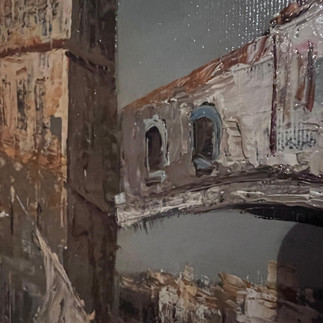Should AI Create Art?
- Tom Archer
- Jul 3, 2024
- 3 min read
Updated: Feb 10
In the summer of 2024, I was invited to a fantastic event that demonstrated the power of natural language AI and image creation. This event challenged me to think about the role of AI in creativity.
🌍 Saatchi Gallery | London
The event showcased AI-generated art. Each attendee was asked to describe themselves and the room where the artwork would be displayed. This information was then used with advanced prompt engineering to generate an abstract piece.
As you can see from the video I shot and the photos of the standout piece, we are, for all intents and purposes, at an art gallery showcasing a collection of artwork—art you could believe was man-made.
It's not until you look closely that you start to see the AI interpretations and the flaws in the output. It reminded me of the early days of voice recognition software like Siri, where every now and then, it would throw a curveball—"Calling John" when you actually said, "Hey Siri, play Jon Bon Jovi." I can see how we got there, but that's not what I meant.
This is mine. Add a comment with your thoughts on my description.

Looking closely at these close-ups, you can see the imperfections I'm referring to. As software and hardware advance, I can see why it interprets a tree the way it does. Many other elements in the image resemble things—maybe a person or a boulder—but it's not entirely clear.
Regardless of how you feel about AI-generated art, you can't take away how impressive the technology is.
Let's compare this AI art with hand-painted pieces.

This is an oil painting of the Rialto Bridge in Venice, Italy. It is a real place, and layers of oil colour are added and worked in a specific order to represent an illustration of a location. It's not a photograph, it's not a perfect image—it's an interpretation of a moment in time.
Looking closer, the artist has used marks, layers, and scrapes to interpret a sail on a boat. This is no different from the illustrations of the tree in the AI-generated image. And like the AI illustration, the artist has probably made composition issues, colour inconsistencies, or shading errors. The artist will have built up more layers, reworked a section or object, and refined the piece until they were happy.
AI follows a similar process, iterating and evolving, expanding the prompt, and setting more rules. The difference is time. One takes many hours, weeks, or even months to handcraft, where passion is felt and reflected in the hard work, quality, and subject. On the other hand, a bespoke AI illustration, though following a similar process, may take only a few days to perfect and can be produced relatively cheaply. One is a passion piece, and the other is an abstract portrait designed to complement a space in my home.
What about mass-produced copies and prints?

This piece of Embankment, London, is a highly mass-produced print, stretched on canvas, 60 inches across. It cost me less than a meal out.
It's a lovely item that covers a large wall and brings me joy. It's flawless in its manufacture and composition. Still, it lacks the passion and enjoyment I get from my oil paintings or AI-generated pieces. You don't need to be an expert art dealer to know this is a mass-produced copy, yet it still hangs among the other pieces.
My Conclusions
This is the right point to conclude. For me, AI-generated art is what artificial pearls or lab diamonds are to jewellery. More people can enjoy beautiful jewellery and art. Still, no matter how striking or imagination-capturing it is, in the back of your mind, you know it's not quite the real deal.
Some people are happy with a designer handbag replica, others don't realise their bag is a copy, and some would never dream of owning one.
If you want to collect a passion-filled, handcrafted illustration, nothing compares to a genuine, artificial painting. But suppose you're looking for the perfect piece to complement a room's design or make a bespoke statement. In that case, AI-generated art might solve that for you.
And if you need a cost-effective wall filler, there's a market for that, too. Most DIY stores sell mass-produced pieces in various shapes, sizes, and frames, making it easy to find something that fits. Art has never been more accessible.
Thomas Archer



















